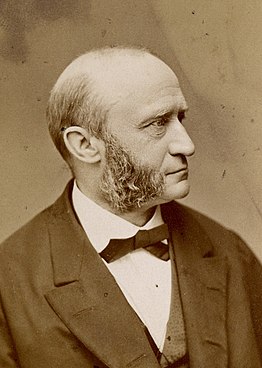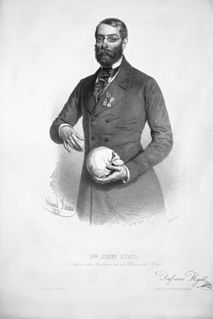Arianism is a nontrinitarian Christological doctrine which asserts the belief that Jesus Christ is the Son of God who was begotten by God the Father at a point in time, a creature distinct from the Father and is therefore subordinate to him, but the Son is also God. Arian teachings were first attributed to Arius, a Christian presbyter in Alexandria of Egypt. The teachings of Arius and his supporters were opposed to the theological views held by Homoousian Christians, regarding the nature of the Trinity and the nature of Christ. The Arian concept of Christ is based on the belief that the Son of God did not always exist but was begotten within time by God the Father.

The First Council of Nicaea was a council of Christian bishops convened in the Bithynian city of Nicaea by the Roman Emperor Constantine I in AD 325.

Arius was a Libyan presbyter and ascetic, and priest in Baucalis in Alexandria, Egypt. His teachings about the nature of the Godhead in Christianity, which emphasized God's uniqueness and the Christ's subordination under the Father, and his opposition to what would become the dominant Christology, Homoousian Christology, made him a primary topic of the First Council of Nicaea, which was convened by Emperor Constantine the Great in 325.

Martin Hinrich Carl Lichtenstein was a German physician, explorer, botanist and zoologist.

Franz Emil Melde was a German physicist and professor. A graduate of the University of Marburg under Christian Ludwig Gerling, he later taught there, focusing primarily on acoustics, also making contributions to fields including fluid mechanics and meteorology. He began in 1860 as Gerling's assistant at the University's Mathematical and Physical Institute, succeeding him in 1864.

Devil May Cry 2 is an action-adventure hack and slash shooter video game developed and published by Capcom in 2003. The game is a sequel to Devil May Cry. In terms of chronological order, the game's events are set after the events of Devil May Cry 3: Dante's Awakening and prior to Devil May Cry 4.

Ernst Wilhelm Ritter von Brücke was a German physician and physiologist. He is credited with contributions made in many facets of physiology.

St Alexander I of Alexandria, 19th Pope of Alexandria & Patriarch of the See of St. Mark. During his patriarchate, he dealt with a number of issues facing the Church in that day. These included the dating of Easter, the actions of Meletius of Lycopolis, and the issue of greatest substance, Arianism. He was the leader of the opposition to Arianism at the First Council of Nicaea. He also is remembered for being the mentor of the man who would be his successor, Athanasius of Alexandria, who would become one of the leading Church fathers.

Franz Hermann Troschel was a German zoologist born in Spandau.

The Mekong snail-eating turtle is a species of turtle in the family Geoemydidae. It was monotypic within the genus Malayemys until Brophy reevaluated Malayemys macrocephala, which has been long time considered to be a synonym of M. subtrijuga.

Arius is a genus of catfishes of the family Ariidae. The genus Arius is distributed in brackish and fresh waters of Eastern Africa and south to Southeast Asia.
Rudolf Robert Maier was a German pathologist who was a native of Freiburg im Breisgau.

Friedrich Wilhelm Schulz was a German officer, radical, and social democratic publisher in Hesse. His most famous works are Der Tod des Pfarrers Friedrich Ludwig Weidig as well as Die Bewegung der Produktion, which Karl Marx quoted extensively in his 1844 Manuscripts. Schulz was the first to describe the movement of society "as flowing from the contradiction between the forces of production and the mode of production," which would later form the basis of historical materialism. Marx continued to praise Schulz's work decades later when writing Das Kapital.
Karl Langer, Ritter von Edenberg was an Austrian anatomist. He is known for his work in the field of topographical anatomy.

The threadfin sea catfish, also called the Hamilton's catfish, marine catfish or jella, is a species of sea catfish in the family Ariidae. It was described by Francis Buchanan-Hamilton in 1822, originally under the genus Pimelodus. It is migratory and is found in tropical brackish and marine waters in the Indo-western Pacific region, including Bangladesh, India, Cambodia, Malaysia, the Philippines, Pakistan, Sri Lanka, Myanmar, Hong Kong, Thailand, Singapore, and China. It reaches a maximum standard length of 40 cm (16 in), but more commonly reaches an SL of 15 cm (5.9 in).
Arius leptonotacanthus is a species of sea catfish in the family Ariidae. It was described by Pieter Bleeker in 1849. It is known from tropical brackish and marine waters in the western Pacific. It reaches a maximum total length of 21 cm (8.3 in).
Arius oetik is a species of sea catfish in the family Ariidae. It was described by Pieter Bleeker in 1846. It is known from tropical marine and brackish waters in the western Pacific. It reaches a maximum total length of 22.5 cm (8.9 in). Its diet consists of mussels, flathead locust lobsters, shrimp, conger eels, ponyfish, squids and Indian mackerels.
The squirrelheaded catfish is a species of sea catfish in the family Ariidae. It was described by Pieter Bleeker in 1855. It inhabits tropical marine and brackish waters in the western Pacific region, including eastern Thailand and Borneo. It reaches a maximum total length of 60 cm (24 in).

The shovelnose sea catfish, also called the short-nosed catfish or the marine catfish, is a species of sea catfish in the family Ariidae. It was described by Achille Valenciennes in 1840. It is a non-migratory species which inhabits tropical marine and brackish waters in the Indo-western Pacific region, including Indonesia, India, Pakistan, the Philippines and Thailand. It dwells at a depth range of 0 to 20 m. It reaches a maximum NG length of 39.5 cm (15.6 in), while commonly reaching a total length of 12 cm (4.7 in).














